Solicita ahora para formar parte de nuestra próxima grupo de Becados en Ciencia científicos comunitarios y líderes comunitarios.
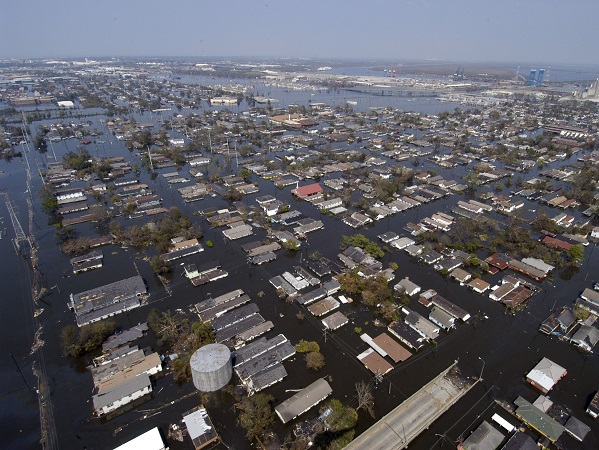
050902-N-5328N-228 New Orleans (Sept. 2, 2005) - Four days after Hurricane Katrina made landfall on the Gulf Coast, many parts of New Orleans remain flooded. The Navy's involvement in the humanitarian assistance operations is led by the Federal Emergency Management Agency (FEMA), in conjunction with the Department of Defense. U.S. Navy photo by Gary Nichols (RELEASED)
The Team
John Pardue, Department of Civil & Environmental Engineering, Louisiana State University, [email protected]
Beth Butler, A Community Voice, [email protected]
Resultados
The focus of the Lower 9th Ward New Orleans project was to work with a hydrologist to better understand and tackle the chronic flooding and blight issues the neighborhood has faced since Hurricane Katrina hit in 2005. Abandoned and blighted properties left in the wake of the storm exacerbate stormwater flooding, create an unsafe environment for young people, harbor illicit behavior, attract unwelcome wildlife and often trigger PTSD in those that survived the storm. Given the complex social and environmental factors these properties present, Beth Butler and Dr. John Pardue identified a creative way to address the issue: bioswales. These low-maintenance nature parks store and treat stormwater on-site, while providing an aesthetically pleasing environment, filled with native plants that can help improve air quality.
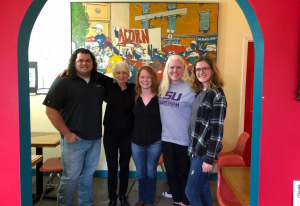
Beth Butler (2nd from left) poses with LSU Engineering students
John’s environmental engineering students at LSU worked with Beth and A Community Voice to develop design criteria for bioswales that can store and treat stormwater prior to discharge into adjacent waterbodies. This included laboratory experiments, community consultation, and mathematical modeling.
A large component of this work was to consult with community members in the Lower 9th Ward on their vision for bioswales. Together, with Beth’s guidance, the LSU students identified people with strong knowledge to speak to the issue of blight and flooding. Community members were interviewed about the history of the ward and asked about the value of bioswales in improving the chronic blight, flooding, and air quality issues. LSU students produced a report detailing the interviews, a cost analysis, as well as their methodology for testing bioretention and air pollution remediation (see below).
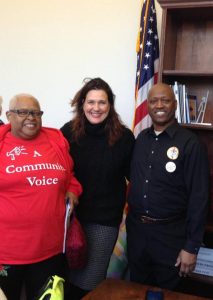
Debra Campell and Rev. Richard Bell of A Community Voice with Councilwoman Kristin Palmer (center)
During the project, the team had two meetings with New Orleans council members. A Community Voice has also reached out to the mayor’s office about adopting a more comprehensive plan for addressing the abandoned and blighted properties across the 9th Ward. The city is currently clearing lots and the group wants to reduce the regulatory hurdles preventing them from installing bioswales on abandoned lots.
El futuro
A Community Voice plans to continue its efforts in lobbying New Orleans’ government to adopt a plan for addressing blighted properties that includes bioswales. In the meantime, John and LSU will be exploring opportunities to install some bioswale pilots – which ideally can be showcased to others to expand a program.
Resultados del proyecto:
Articles
Community group demands action from city on blight, WDSU News, December 13, 2018
Blight to Bioswales: LSU CEE Student Project to Health Lower Ninth Ward, LSU College of Engineering, January 31, 2019
LSU student project designed to help Lower 9th Ward, NOLA.com, February 1, 2019
Impactos del proyecto:
Reflections
A partir de este proyecto, otros pueden aprender mejores formas de asociarse con Thriving Earth Exchange para sus propios fines. Por ejemplo,
El equipo observó que lo siguiente contribuyó al éxito del proyecto:
Sin embargo, el equipo haría algunas cosas de forma diferente si tuviera la oportunidad de repetir el proyecto:
A otros equipos que actualmente llevan a cabo proyectos de Intercambio para una Tierra Próspera y a los que prevén realizar un proyecto de Intercambio para una Tierra Próspera, el equipo les recomienda:
The largest of New Orleans’ 17 wards, the 9th Ward is located on the easternmost downriver portion of the city. In the early 1920s, in order to connect the Mississippi River to Lake Pontchartrain, an industrial canal was dredged through the neighborhoods fringing the river. During Hurricane Katrina in 2005, the neighborhoods on either side of the Industrial canal experienced catastrophic flooding. The Lower 9th Ward garnered national attention with photos and footage of residents stranded on rooftops and helicopters rescuing residents trapped by the flood waters.
In the years following Katrina, residents of the 9th Ward continue to face a variety of challenges related to water-main breaks, sewage back-ups, mold/mildew outbreaks, and the long-term threat of sea level rise. Although the ward has yet to experience flooding as catastrophic as Katrina, smaller flood events have occurred. During an August 5, 2017 storm that dropped close to 10 inches in some neighborhoods, the pumps installed to prevent flooding throughout New Orleans failed, and water ended up pooling in the streets with nowhere to drain. Contaminated drinking water prompted boil advisories for 9th Ward residents and this left many worried about the next big storm.
In addition to these chronic issues, 9th Ward residents have complained about disruptive explosions occurring along the industrial canal. Residents have noted cracked walls as a result of the blasts and remain confused about the nature of the activities.
In 2009, a local non-profit group called A Community Voice was established to provide a community voice to the working, poor, elderly, women, children and families in New Orleans. The organization brings together people with common interests and concerns related to issues that affect their everyday lives. A Community Voice would like to obtain a better understanding of the causes of flooding in the 9th Ward, the reason for the explosions along the canal, and how changes to the canal and levee will affect flooding in their neighborhood. The organization would like to work with a dedicated hydrologist to investigate the flooding, synthesize any available reports and develop next steps or proposed solutions. A Community Voice will use their enhanced understanding to have productive interactions with local decision-makers.
This project has been conceived and designed in partnership with community leaders at A Community Voice and with our national partner, Flood Forum USA.
Durante la reunión de otoño de 2021 de la AGU en Nueva Orleans, tuvimos el honor de conocer a muchos miembros de la comunidad que están trabajando para que los barrios de la región sean más sanos, estén más conectados y sean más resistentes. He aquí una muestra de lo que vimos.
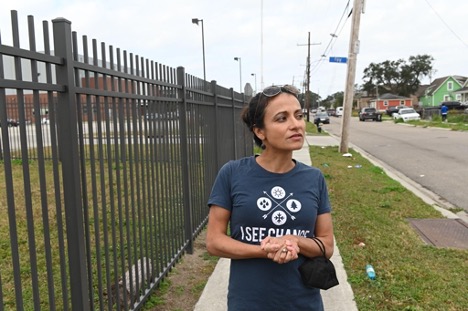 Julia Kumari Drapkin, líder de la comunidad, frente a un campo de fútbol de Gentilly, donde ahora se lleva a cabo un proyecto de retención de agua. Los datos de origen comunitario del Proyecto Thriving Earth Exchange de Gentilly fue un catalizador que dio lugar a la remodelación y reasignación de 4,8 millones de dólares para mitigar las inundaciones en el campus de St. Bernard, en Gentilly. Bernard, en Gentilly. La unidad subterránea se amplió en 2,5 veces, almacenando hasta 5 millones de galones de aguas pluviales en cuencas de detención subterráneas, las mayores de su clase en el Sur.
Julia Kumari Drapkin, líder de la comunidad, frente a un campo de fútbol de Gentilly, donde ahora se lleva a cabo un proyecto de retención de agua. Los datos de origen comunitario del Proyecto Thriving Earth Exchange de Gentilly fue un catalizador que dio lugar a la remodelación y reasignación de 4,8 millones de dólares para mitigar las inundaciones en el campus de St. Bernard, en Gentilly. Bernard, en Gentilly. La unidad subterránea se amplió en 2,5 veces, almacenando hasta 5 millones de galones de aguas pluviales en cuencas de detención subterráneas, las mayores de su clase en el Sur.
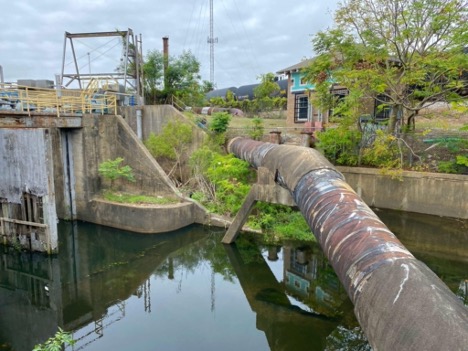 Vista de la estación de bombeo nº 3 del distrito 7. La infraestructura de control de inundaciones es crítica en Nueva Orleans 24/7 - hay alguien trabajando en cada estación de bombeo de la ciudad a todas horas, todos los días, 365 días al año. Aquí vemos el canal y la tubería de trasvase que saca el agua del barrio y la bombea al lago Pontchartrain.
Vista de la estación de bombeo nº 3 del distrito 7. La infraestructura de control de inundaciones es crítica en Nueva Orleans 24/7 - hay alguien trabajando en cada estación de bombeo de la ciudad a todas horas, todos los días, 365 días al año. Aquí vemos el canal y la tubería de trasvase que saca el agua del barrio y la bombea al lago Pontchartrain.
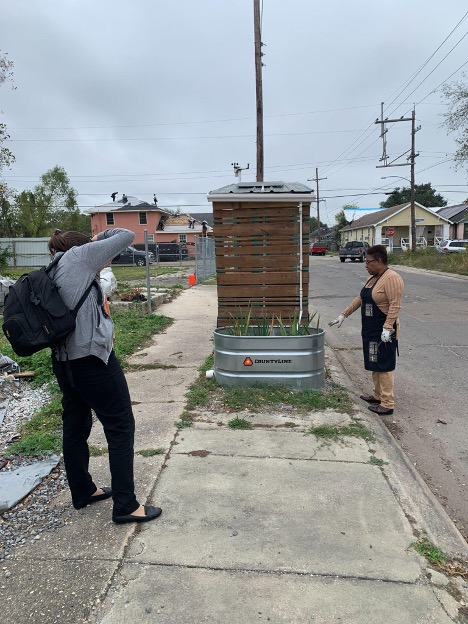 Beth Bagley, directora de AGU Design, fotografía a Angela Chalk, fundadora de Healthy Community Services, delante de una marquesina de autobús diseñada con un tejado inclinado y un jardín de lluvia para reducir las inundaciones. También incluye una estación de carga que funciona con energía solar y que los residentes pueden utilizar para cargar aparatos electrónicos, un recurso valioso en caso de apagón debido a huracanes u otras catástrofes climáticas. Angela Chalk dirigió la comunidad de una Tierra próspera. proyecto sobre el seguimiento de los efectos de la ecologización en el efecto isla de calor urbano, la captación de agua y los retos sociales, y es becaria de Ciencias Comunitarias en un nuevo proyecto en el 7th Ward.
Beth Bagley, directora de AGU Design, fotografía a Angela Chalk, fundadora de Healthy Community Services, delante de una marquesina de autobús diseñada con un tejado inclinado y un jardín de lluvia para reducir las inundaciones. También incluye una estación de carga que funciona con energía solar y que los residentes pueden utilizar para cargar aparatos electrónicos, un recurso valioso en caso de apagón debido a huracanes u otras catástrofes climáticas. Angela Chalk dirigió la comunidad de una Tierra próspera. proyecto sobre el seguimiento de los efectos de la ecologización en el efecto isla de calor urbano, la captación de agua y los retos sociales, y es becaria de Ciencias Comunitarias en un nuevo proyecto en el 7th Ward.
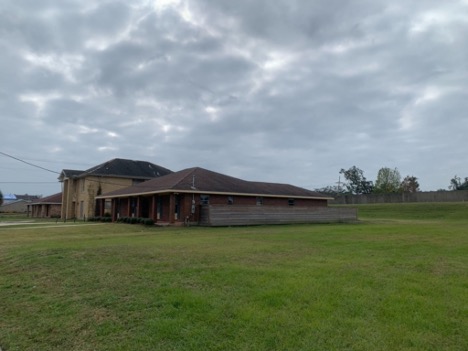 El Museo de la Casa Inundada, situado en el lugar donde se rompió el muro de contención del canal de la avenida London, es un recordatorio aleccionador de los efectos del huracán Katrina. Durante la tormenta, la casa fue empujada al otro lado de la calle y dio un giro de 180 grados. Hoy se ha devuelto a su parcela original y se conserva como museo, donde los visitantes pueden mirar a través de las ventanas de tormenta para ver cómo el huracán devastó su interior. Al fondo se ve el muro de contención del canal de la avenida London, que se rompió a pocos metros de la casa.
El Museo de la Casa Inundada, situado en el lugar donde se rompió el muro de contención del canal de la avenida London, es un recordatorio aleccionador de los efectos del huracán Katrina. Durante la tormenta, la casa fue empujada al otro lado de la calle y dio un giro de 180 grados. Hoy se ha devuelto a su parcela original y se conserva como museo, donde los visitantes pueden mirar a través de las ventanas de tormenta para ver cómo el huracán devastó su interior. Al fondo se ve el muro de contención del canal de la avenida London, que se rompió a pocos metros de la casa.
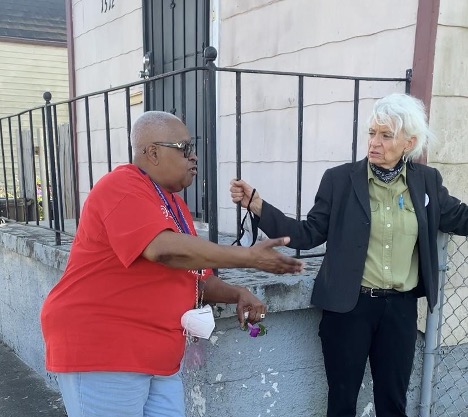 Beth Butler, líder de la comunidad, y Debra Campbell, residente, en la esquina del emplazamiento de un futuro bioswale y viviendas asequibles en el distrito 8 de Nueva Orleans. El diseño previsto integra jardines de plantas autóctonas y espacios privados al aire libre para promover la salud física y mental de los residentes como parte de los proyectos Thriving Earth Diseño de bioswales para mejorar la calidad del aire, la serenidad y reducir el riesgo de inundaciones y Evaluación de las inundaciones y la hidrodinámica para la revitalización comunitaria.
Beth Butler, líder de la comunidad, y Debra Campbell, residente, en la esquina del emplazamiento de un futuro bioswale y viviendas asequibles en el distrito 8 de Nueva Orleans. El diseño previsto integra jardines de plantas autóctonas y espacios privados al aire libre para promover la salud física y mental de los residentes como parte de los proyectos Thriving Earth Diseño de bioswales para mejorar la calidad del aire, la serenidad y reducir el riesgo de inundaciones y Evaluación de las inundaciones y la hidrodinámica para la revitalización comunitaria.
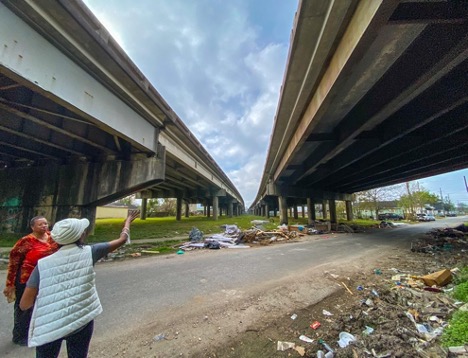 Amy Stelly y Tamah Yisrael, líderes comunitarias, señalan el corredor de la I-10 en el 7th Ward de Nueva Orleans. Su organización, Claiborne Avenue Alliance, trabajó con Thriving Earth Exchange para evaluar las repercusiones de la autopista I-10 que pasa por encima de Claiborne Avenue. Su trabajo contribuyó a una conversación nacional con Nueva Orleans en el centro.
Amy Stelly y Tamah Yisrael, líderes comunitarias, señalan el corredor de la I-10 en el 7th Ward de Nueva Orleans. Su organización, Claiborne Avenue Alliance, trabajó con Thriving Earth Exchange para evaluar las repercusiones de la autopista I-10 que pasa por encima de Claiborne Avenue. Su trabajo contribuyó a una conversación nacional con Nueva Orleans en el centro.
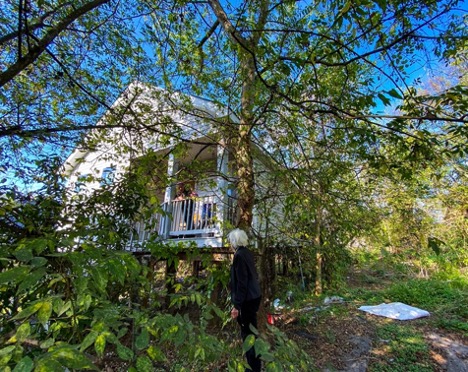 Visitar viviendas afectadas por las inundaciones en el 9th SalaNueva Orleans, con Beth Butler, líder de la comunidad. Levantar las casas sobre pilotes como este las protege de las inundaciones; el terreno de al lado se convertirá en un jardín de lluvia y un canal biológico para proteger aún más de las inundaciones y embellecer el barrio.
Visitar viviendas afectadas por las inundaciones en el 9th SalaNueva Orleans, con Beth Butler, líder de la comunidad. Levantar las casas sobre pilotes como este las protege de las inundaciones; el terreno de al lado se convertirá en un jardín de lluvia y un canal biológico para proteger aún más de las inundaciones y embellecer el barrio.
Liderazgo comunitario
Biografía próximamente
Beth Butler, Executive Director of A Community Voice, and Reverend Richard Bell, board member of A Community Voice, are community leads on the project.
Enlace científico
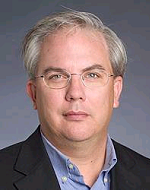
Dr. John Pardue is the Elizabeth Howell Stewart Professor of Civil & Environmental Engineering at Louisiana State University. He directs the Hazardous Substance Research Center at LSU. Dr. Pardue’s research group investigates the fate and transport of chemicals in the environment focused primarily on chemicals in wetlands and aquatic systems, environmental impacts of disasters and shoreline restoration techniques. Currently he is performing research on the fate and remediation options for the Deepwater Horizon oil spill in Louisiana marshes and barrier islands. He has published over 70 peer-reviewed papers and conducted research for federal agencies such as EPA, NSF, NOAA, and DOD. His research has led to development of a number of innovative technologies including the sustainable constructed wetland approach for treating contaminated groundwater. His group published the first peer-reviewed scientific paper on Hurricane Katrina (Pardue, J.H., W.M. Moe, D. McInnis, L.J. Thibodeaux, K.T. Valsaraj, E. Maciasz, I. van Heerden, N. Korevec and Q.Z. Yuan. 2005. Chemical and microbiological parameters in New Orleans floodwater following Hurricane Katrina. Environ. Sci. Technol. 39:8591 – 8599).
This project is part of one of Thriving Earth Exchange’s new cohorts. Thriving Earth Exchange has partnered with Flood Forum USA which supports grassroots flood groups across the country by helping them develop strategies for a sustainable future. Thriving Earth Exchange is working with 15 of their grassroots groups to connect them with scientists who can help them better characterize neighborhood-level flood risks and work effectively with local decision makers to mitigate those risks.
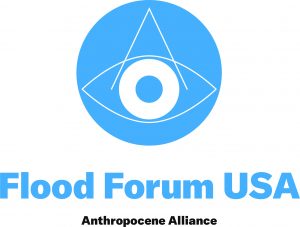
ISeeChange se dedica a capacitar a las comunidades para que documenten y comprendan su entorno, el tiempo y el clima con el fin de aumentar su resiliencia. ISeeChange moviliza a las comunidades para que compartan historias y microdatos sobre los impactos climáticos con el fin de informar y mejorar la adaptación al clima y el diseño de infraestructuras. Su plataforma, herramientas e investigaciones ofrecen a los residentes formas equitativas e iterativas de personalizar, medir y hacer un seguimiento de los impactos del cambio climático y participar mejor en las decisiones de adaptación de la comunidad.
Each post is synced with weather and climate data and broadcast to the community to investigate bigger picture climate trends. Over time, community members can track how climate is changing, season to season, year to year, and understand the impacts on daily life.
ISeeChange is a strategic partner of Thriving Earth Exchange as community members use their platform and tools to better characterize, visualize, and communicate neighborhood-level climate trends and co-develop solutions to mitigate those risks.
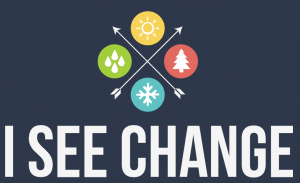
(c) 2024 Thriving Earth Exchange